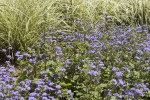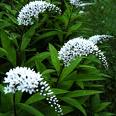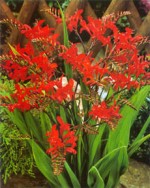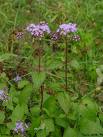 Some plants are just like rambunctious children. They don’t mean to upset the order of things but their energy and vitality allow them to bully those that are more restrained and even crowd them out. Don’t get me wrong. I love these 5 favorite thugs and initially invited them into my garden. They grew with abandon and won my adoration and praise. I love their look and presence but I also know that I have to control them with logical reasoning and a firm hand. It is sometimes a tough love situation.
Some plants are just like rambunctious children. They don’t mean to upset the order of things but their energy and vitality allow them to bully those that are more restrained and even crowd them out. Don’t get me wrong. I love these 5 favorite thugs and initially invited them into my garden. They grew with abandon and won my adoration and praise. I love their look and presence but I also know that I have to control them with logical reasoning and a firm hand. It is sometimes a tough love situation.
My list reflects experience in both Maryland and North Carolina. They are both in zone 7 and have the same problem of heat and humidity during the summer. People in other parts of the country with different temperatures, water regimes, soil conditions etc. may have a very different experience with these plants. I truly believe that any plant can become a thug if given the right growing conditions. I guess my garden is a great place for these plants but your experience may be very different.
Common Sundrop (Oenethera fructicosa)
The bright yellow flowers borne in the clusters on top of 18” stems are welcome in my garden each spring. By mid June, however, the plants have run all over the garden taking up the space of 5 clumps of other plants and threatening to take over the yucca. At that point I pull up the sundrops by the handfuls with no fear that I will never see them again and sure enough they reappear the following spring. Hardy in zones 4-8, sundrops like full sun and tolerate dry soil.
Gooseneck Loosestrife (Lysimachia clethroides)
 The small white flowers are borne in terminal racemes that are gracefully curved to resemble a goose’s neck. A clump of these charming flower heads is a whimsical addition to any garden and I always look forward to their appearance. The plant is 2′-3′ tall and quickly forms a clump about 3’ wide. It likes moist soils and full sun but tolerates less and is hardy in zones 3-8. It increases aggressively by underground stems but is easily pulled out from their territorial expansion. It is a good cut flower too so you have a good use for the ones you pull up during the bloom season.
The small white flowers are borne in terminal racemes that are gracefully curved to resemble a goose’s neck. A clump of these charming flower heads is a whimsical addition to any garden and I always look forward to their appearance. The plant is 2′-3′ tall and quickly forms a clump about 3’ wide. It likes moist soils and full sun but tolerates less and is hardy in zones 3-8. It increases aggressively by underground stems but is easily pulled out from their territorial expansion. It is a good cut flower too so you have a good use for the ones you pull up during the bloom season.
Crocosmia (Crocosmia x Curtonus ‘Lucifer’)
 The unusual scarlet-red flowers are borne on top of stiffly arching 3’ stems from clumps of tall sword like foliage. The flower are quite beautiful, attract butterflies, and are good in bouquets. Hardy in zones 5-9, the plants grow from corms that increase in number each year. The problem arises when they flop and cover the surrounding plants. As the number of corms and plants increase the area of flopping increases until a significant number of other plants are impacted and hurt. Removing the corms is easy; a quick tug of a stem and out the corm pops. As a bonus, it attracts hummingbirds and is a good cut flower.
The unusual scarlet-red flowers are borne on top of stiffly arching 3’ stems from clumps of tall sword like foliage. The flower are quite beautiful, attract butterflies, and are good in bouquets. Hardy in zones 5-9, the plants grow from corms that increase in number each year. The problem arises when they flop and cover the surrounding plants. As the number of corms and plants increase the area of flopping increases until a significant number of other plants are impacted and hurt. Removing the corms is easy; a quick tug of a stem and out the corm pops. As a bonus, it attracts hummingbirds and is a good cut flower.
Hardy Ageratum (Eupatorium coelestinum)
 I fight this plant all summer (it emerges late sparing me during the spring) but I always make sure that enough survives so I can enjoy its beautiful fuzzy azure blue flowers in the fall. It is weedy and floppy in my garden but I forgive it because there is nothing to replace it. It grows up to 3’ tall, is hardy in zones 6-10, and thrives on full sun and a moderate amount of moisture.
I fight this plant all summer (it emerges late sparing me during the spring) but I always make sure that enough survives so I can enjoy its beautiful fuzzy azure blue flowers in the fall. It is weedy and floppy in my garden but I forgive it because there is nothing to replace it. It grows up to 3’ tall, is hardy in zones 6-10, and thrives on full sun and a moderate amount of moisture.
Grape Leaf Anemone (Anemone vitifolia)
 I grow both the pink and white varieties in my secret garden where I can enjoy their simple flowers close up in the fall when they bloom. The hassle with them begins in the spring when many shoots emerge from their stoloniferous stems and I have to force myself to remove most of them or be pushed out of the garden by their vigorous growth. Even then the hassle is not over because their 18″-34″ flowering stems lean badly and I have to brace them up. No matter, the flowers are lovely and well worth the hassle. Hardy in zones 5-8, these anemones do well in sun or part shade with moderate moisture.
I grow both the pink and white varieties in my secret garden where I can enjoy their simple flowers close up in the fall when they bloom. The hassle with them begins in the spring when many shoots emerge from their stoloniferous stems and I have to force myself to remove most of them or be pushed out of the garden by their vigorous growth. Even then the hassle is not over because their 18″-34″ flowering stems lean badly and I have to brace them up. No matter, the flowers are lovely and well worth the hassle. Hardy in zones 5-8, these anemones do well in sun or part shade with moderate moisture.

Your Grape Leaf Anemone looks a lot like rose of sharon is that another name for it? If not, what is the difference?
I also have A LOT of common sundrops. Ddidn’t know their name before this, but they are quite pretty and I too don’t worry about tearing them out. they always come back.
There is always a problem with common names but I am not aware that this plant is known by the name of rose of Sharon. To me, rose of Sharon is Hibiscus syriacus, a flowering shrub. The flowers look a lot alike but rose of Sharon the anemone is definitely a herbaceous perennial and dies down each winter. The rose of Sharon that I know can be a thug! Thanks for your question.